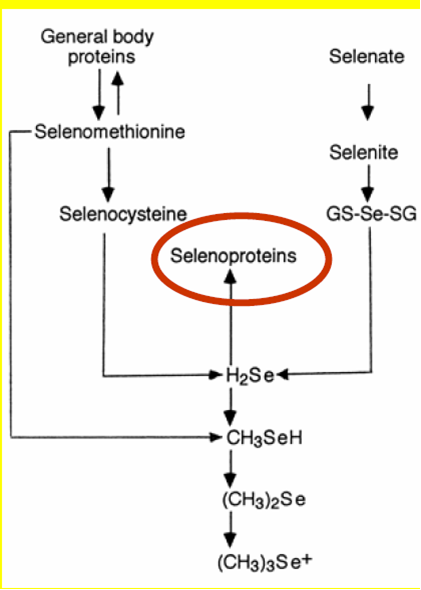Introduction 2ece: Difference between revisions
No edit summary |
No edit summary |
||
| Line 1: | Line 1: | ||
The trace element Selenium (Se) has been known to cause major health problems in livestock and man in soils which are rich in this mineral [[http://compbio.chemistry.uq.edu.au/mediawiki/index.php/References_2ece Birringer, M., Pilawa, S. and Flohe, L. (2002]]). Due to this association of selenium rich soils with these health problems, the beneficial role of this element was severely overlooked until the 1950's when it was discovered to be involved in the synthesis of most enzymes, like redox enzymes. The roles of selenium into important biochemical reactions was pioneered by Thressa Stadtman [http://history.nih.gov/exhibits/stadtman/nose_selenium.htm selenium biochemistry] by the early 1970’s after an observation that bacterial cells required selenium, in their synthesis of an important enzyme, glycine reductase. Further research was carried out and it was found that this element can substitute sulphur in the cysteine amino acid and form a 21st amino acid dubbed as selenocysteine. Selenium can as well found in selenomethionine amino acid Selenium exists in the form of selenate in soil and after absorption it undergoes a series of biochemical steps that involves a passage or binding of one protein to another. It is as well known that selenium in mammals has nutritional benefits and can be transported via haemoglobin | The trace element Selenium (Se) has been known to cause major health problems in livestock and man in soils which are rich in this mineral [[http://compbio.chemistry.uq.edu.au/mediawiki/index.php/References_2ece Birringer, M., Pilawa, S. and Flohe, L. (2002]]). Due to this association of selenium rich soils with these health problems, the beneficial role of this element was severely overlooked until the 1950's when it was discovered to be involved in the synthesis of most enzymes, like redox enzymes. The roles of selenium into important biochemical reactions was pioneered by Thressa Stadtman [http://history.nih.gov/exhibits/stadtman/nose_selenium.htm selenium biochemistry] by the early 1970’s after an observation that bacterial cells required selenium, in their synthesis of an important enzyme, glycine reductase. Further research was carried out and it was found that this element can substitute sulphur in the cysteine amino acid and form a 21st amino acid dubbed as selenocysteine. Selenium can as well found in selenomethionine amino acid Selenium exists in the form of selenate in soil and after absorption it undergoes a series of biochemical steps that involves a passage or binding of one protein to another. It is as well known that selenium in mammals has nutritional benefits and can be transported via haemoglobin and the mechanism and/or protein that mediate its transition from the blood to the whole areas in mammalian body where Selenium plays some important roles has not yet been clearly figured out (Haratake et al, 2008[[http://compbio.chemistry.uq.edu.au/mediawiki/index.php/References_2ece]]) . | ||
Revision as of 10:47, 6 June 2008
The trace element Selenium (Se) has been known to cause major health problems in livestock and man in soils which are rich in this mineral [Birringer, M., Pilawa, S. and Flohe, L. (2002]). Due to this association of selenium rich soils with these health problems, the beneficial role of this element was severely overlooked until the 1950's when it was discovered to be involved in the synthesis of most enzymes, like redox enzymes. The roles of selenium into important biochemical reactions was pioneered by Thressa Stadtman selenium biochemistry by the early 1970’s after an observation that bacterial cells required selenium, in their synthesis of an important enzyme, glycine reductase. Further research was carried out and it was found that this element can substitute sulphur in the cysteine amino acid and form a 21st amino acid dubbed as selenocysteine. Selenium can as well found in selenomethionine amino acid Selenium exists in the form of selenate in soil and after absorption it undergoes a series of biochemical steps that involves a passage or binding of one protein to another. It is as well known that selenium in mammals has nutritional benefits and can be transported via haemoglobin and the mechanism and/or protein that mediate its transition from the blood to the whole areas in mammalian body where Selenium plays some important roles has not yet been clearly figured out (Haratake et al, 2008[[1]]) .
Adapted and modified from: Journal of nutrition 30: 1653 (2000) by Thiel File:TlectSel selenoproteins.pdf
History of selenium biochemistrySelenium biochemistry video
movie file
